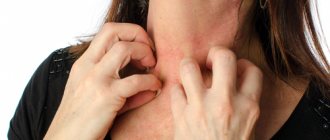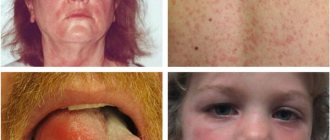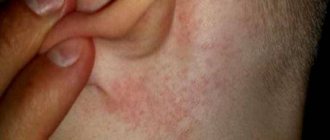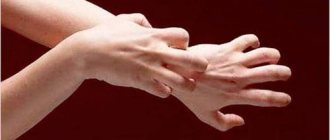Skin itching and rashes are one of the most common reasons for visiting a doctor. But sometimes the root cause of such a problem has nothing to do with dermatology. Psychogenic itching (or neurodermatosis) is one of the forms of somatoform neuroses, in which not disorders of the psychoemotional sphere, but somatovegetative manifestations come to the fore. And often before contacting our clinic, the patient visits a therapist and dermatologist for many months, undergoes expensive courses of treatment, which, at best, give only short-term results. But doctors at the mental health center very often encounter somatoform neuroses, which is why we can quickly make a diagnosis and individually select tactics for medication and psychotherapeutic correction.
Psychogenic skin itching: causes of the syndrome
Neurodermatosis is a consequence of either some severe psychotraumatic situation or prolonged exposure to a stress factor. The trigger can be:
- family conflicts, divorce;
- your own serious illness or a diagnosed pathology in someone close to you;
- financial difficulties, loss or change of job, credit obligations;
- moving;
- threat to social status due to the publication of personal data, bullying on social networks.
The risk of somatoform neurotic disorders increases with chronic fatigue, intense physical and emotional stress that is not appropriate for age and general health.
As practice shows, people who are prone to increased anxiety and restlessness are more susceptible to the disease. They usually see everything around them, including their future, only in a pessimistic light, and react very painfully to any conflict situations. It is difficult for them to follow their goals, plan their day and work schedule, which also does not have the best effect on their psycho-emotional state.
Notalgia paresthetica is considered an isolated mononeuropathy, manifested by chronic focal itching or paresthesia in the area of the scapula and the skin surrounding this area. There are no specific manifestations of the disease, but manifestations of chronic itching in the form of scratches and abrasions are determined. The etiology of the disease remains unknown, however, there is an assumption that the cause lies in irritation of the posterior nerve roots in the T2-T6 region, which occurs due to degenerative changes in the vertebrae. In this article, we describe a case of notalgia paresthetica in a 55-year-old woman. The patient came to us for medical help with complaints of tingling in the area of the lower angle of the left scapula. Itching first appeared 7 years ago and turned into tingling 4 months ago. Apart from excoriations and a vague focus of hyperpigmentation, no specific skin manifestations of the disease were observed. Skin biopsy showed thinning of the epidermis with pigment loss. The patient was treated with 600 mg gabapentin daily and capsaicin cream with unsatisfactory results.
Introduction
The term nostalgia paresthetica comes from the Greek word "notos", meaning "back", and was first described by Astvatsaturov in 1934. This condition refers to isolated mononeuropathies with chronic localized itching or paresthesia in the scapular region. There are no specific skin manifestations of the disease, with the exception of secondary manifestations of chronic skin itching, such as scratches and abrasions. We described the first case of nootalgia paresthetica reported in Korea in a 55-year-old woman.
Clinical case
A 55-year-old woman came to our clinic for medical help with complaints of a tingling sensation in the area of the lower angle of the left scapula. According to the patient, itching has existed for 7 years with transformation into pain and tingling over the last 4 months. No peculiarities were found in the patient's medical history. Before visiting our clinic, the patient underwent a comprehensive neurological examination in multiple clinics, including an MRI examination of the spine without identifying any pathology. We could not detect any specific lesions on the skin other than excoriations and vague areas of hyperpigmentation (Fig. 1). We performed a skin biopsy from a lesion on the back. Pathohistologically, we found only thinning of the epidermis and the zone of pigment incontinence (Fig. 2). The S-100 protein test was also negative. The patient was diagnosed with Notalgia paresthetica based on the clinical picture. The patient received treatment: Gabapentin 600 mg daily and capsaicin cream externally. Unfortunately, the response to treatment was unsatisfactory.
Discussion
Notalgia paresthetica is a neurocutaneous disorder affecting middle-aged and older adults, occurring twice as often in women as in men. The etiology of the disease remains unknown, although it is assumed that the itching is caused by irritation of the posterior nerve roots in the T2-T6 region, which is associated with degenerative changes in the vertebrae. When examining 12 patients, 9 of them were diagnosed with spinal pathology using R-graphy, including manifestations of osteoarthritis, such as kyphosis, kyphoscoliosis and hyperostosis. Pacresthetic notalgia is usually diagnosed by functional symptoms. Itching is the most common symptom of the disease and is characterized by intermittency, paroxysmal and variable intensity. The disease may be accompanied by paresthesias such as pain, burning sensation, feeling of heat or cold, tingling, numbness and even a foreign body sensation. This leads to chronic scratching and rubbing of the affected area, which in turn manifests itself as hyperpigmentation, and its symptoms resemble the macular form of amyloidase. Secondary manifestations are also the localization of the process in the area of dermatomes T2-T6, which corresponds to the subscapular paravertebral zone. In most cases, notalgia paresthetica is a unilateral process that can equally often affect either side. However, there are bilateral forms and forms with an emphasis on the interscapular region. It is important to clinically exclude other itchy dermatoses in the back area, such as pigmented contact dermatitis, focal parapsoriasis, and neurodermatitis. A more difficult disease for differential diagnosis is early cutaneous amyloidosis, localized on the back even in the initial stages. In such cases, the emphasis in diagnosis should be on the course of the disease and searching for skin lesions in other places.
The results of our histological examination, such as post-inflammatory melanosis, basal hyperpigmentation and pigment incontinence, do not differ significantly from the cases described in other cases. Cutaneous amyloidosis has been described in some cases. This is presumably the result of chronic friction and degeneration of keratinocytes and their degeneration into the protein amyloid. Epidermal proliferation, as seen in lichen simplex chronicus, usually appears in the affected area where itching and chronic friction are present. However, in contrast to this, our patient demonstrated thinning of the epidermis. An explanation for this may be long-term use of topical glucocorticosteroids on the itchy area. This could also lead to a decrease in hyperpigmentation in the lesion.
Springall et al. previously described an increase in sensory epidermal innervation in the lesion, which contributes to the development of disease symptoms. They found that frozen sections of lesions contained high amounts of intradermal protein 9.5 immunoreactive nerve fiber gene products compared with healthy skin from the same patients and control subjects. In a more recent study, Inaloz et al. demonstrated a significant increase in cutaneous nerves using the neural marker S-100. However, Beck S-100 staining did not show nerve proliferation in this case.
To date, there is no specific treatment for notalgia paresthetica, and all published work on the treatment of this condition is anecdotal. Topical capsaicin is the most widely used drug among dermatologists. Transcutaneous electrical nerve stimulation, gabapentin, oxcarbazepine, and botulinum toxin, and narrowband UVB radiation have recently shown promising results. However, in most cases, treatment results were disappointing. Our patient also received moderate doses of gabapentin and topical capsaicin, but we did not receive a satisfactory response to therapy. Non-dermatological, non-invasive treatment for notalgia paresthetica should also include manual spinal work, physical therapy, massage, neck traction, strengthening of the neck muscles, therapy with non-steroidal anti-inflammatory drugs and muscle relaxants. Successful treatment of the disease requires a multidisciplinary approach involving dermatologists, radiologists, orthopedic surgeons and neurologists.
Clinical manifestations of the syndrome
With neurodermatosis, papules, vesicles, and foci of hyperemia characteristic of other forms of dermatitis are usually absent. In addition, the unpleasant sensations do not have a clear localization, but psychogenic itching of the head and neck is more common. Patients describe it as crawling or biting insects, subcutaneous parasites, etc.
In addition to constantly scratching the skin, patients may pull out hair, bite their nails, and pick off dried scabs from scarring wounds. They usually exaggerate physical discomfort, and perceive even minor discomfort as a sign of some serious illness. Therefore, dermatological manifestations of the disease are often combined with other somatovegetative symptoms:
- pain and cramping in the abdominal area, stool disorders, unpleasant taste in the mouth, flatulence;
- shortness of breath, a feeling of lack of air and tightness in the chest, these sensations appear both after minor exertion and at rest;
- increased sweating, hot flashes, redness of the face, neck and chest;
- frequent urination;
- problems in the sexual sphere (more common in men);
- pain and discomfort in the joints, numbness of the skin, cramps and tingling in the muscles, etc.
Itching, like other symptoms of somatoform neurosis, usually intensifies during times of excitement and stress. Because of this, sleep disturbances with nightmares, frequent awakenings at night, daytime sleepiness and increased fatigue are often observed.
Trying to cope with itching, a person intensively scratches the skin, which often causes a secondary infection. Discomfort intensifies, hyperemic, inflamed, painful areas and pustular rashes appear. Moreover, even if it is possible to cope with the infectious process, the itching still persists.
What causes psychogenic itching?
Psychogenic itch is directly related to depression, anxiety and mental disorders. The following symptoms are characteristic of this disease:
- absence of skin changes (redness, peeling, rashes);
- special activity at the peak of emotions and nervous tension.
Doctors note that psychogenic itching often manifests itself in people with a shaky and unstable psyche. Activity can also occur at night. This is exactly the bell that reminds you that it’s time to seek help from a qualified doctor.
Constant itching requires serious medical diagnosis. Only when the cause of the itching is identified, the doctor prescribes specific treatment. According to the observations of our specialists, the treatment of small, adult and mature patients is similar. An integrated approach to solving a problem such as psychogenic itching will help alleviate the patient’s condition.
Diagnosis of neurodermatosis in medical
Doctors at our clinic make a preliminary diagnosis based on medical history. But even despite the obvious signs of the psychogenic nature of the disease, it is necessary to exclude other possible etiological factors of the disease. Therefore, the patient is prescribed the following tests and studies:
- scraping to determine possible pathogenic microflora;
- markers for the presence of an autoimmune inflammatory process, allergies, diabetes;
- tests to assess the functioning of the endocrine and urinary systems;
- blood biochemistry and liver tests;
- According to indications, a comprehensive examination is carried out to identify possible malignant neoplasms.
Signs characteristic of neurodermatosis can also occur with long-term use of medications, psychostimulants, and alcohol. Therefore, doctors ask the patient to be extremely frank - all services are provided strictly anonymously, and our clients do not have to worry about disclosing medical confidentiality.
Itchy skin
Itching is one of the most common dermatological complaints, and it can occur not only in patients with dermatoses, but also in a wide range of general diseases. This is an unpleasant sensation, which is accompanied by a continuous need for response mechanical irritation of the skin. Itching can significantly affect the general condition and quality of life of patients, causing insomnia, anxiety, and in severe cases even lead to depression and suicidal thoughts.
Itching is one of the forms of the skin analyzer, close to other types of skin sensation (touch, pain). Unlike pain, which causes a “withdrawal, avoidance” reflex, with itching a “processing” reflex occurs. Scratching, rubbing, kneading, warming, pinching itchy areas leads to instant, but not long-term, satisfaction. This is due to the fact that during the scratching process, stronger impulses are simulated in the nerve endings, which suppress the conduction of weaker itching signals from the affected areas. Severe itching is relieved only through severe self-harm, leading to the replacement of the sensation of itching with a feeling of pain. If itching exists for a long time, then a focus of pathological excitation is formed in the cerebral cortex and itching from a defensive reaction turns into a standard skin reaction to various external and internal stimuli. At the same time, in response to prolonged scratching, the state of peripheral nerve receptors also changes, which leads to a decrease in the threshold for the perception of itching. Thus, a “vicious circle” is formed, the presence of which explains the difficulties in treating itching.
Itching is caused by mechanical, thermal, electrical or chemical stimulation of unmyelinated nerve fibers, the free nerve endings of which lie at the border of the epidermis and dermis. They are excited either directly or indirectly, through the release of various mediators (histamine, serotonin, proteases, neuropeptides, etc.).
Physiological itching occurs in response to environmental irritants (crawling insects, friction, temperature changes, etc.) and disappears after the cause is eliminated. Pathological itching is caused by changes in the skin or throughout the body and causes a strong need to get rid of the itching by scratching or other means.
Itching can be a symptom of various dermatoses (scabies, pediculosis, atopic dermatitis, allergic dermatitis, eczema, mycoses, psoriasis, lichen planus, etc.) or occur on intact skin due to diseases of the internal organs. Endogenous causes of skin itching are very diverse:
- endocrine and metabolic disorders (diabetes mellitus, hyperthyroidism, hypothyroidism, menopause, hyperparathyroidism);
- liver diseases (biliary cirrhosis, extrarenal cholestasis, hepatitis of various etiologies, etc.);
- chronic renal failure;
- blood diseases (iron deficiency anemia, polycythemia vera, lymphogranulomatosis, leukemia, mastocytosis);
- tumors of internal organs, melanoma;
- autoimmune diseases;
- infectious and parasitic (HIV infection, helminthiasis);
- neurological diseases;
- psychoneuroses;
- pregnancy;
- taking medications;
- age (senile itching).
If the cause of the itching, even with a thorough examination, cannot be identified, then it is defined as itching of unknown origin (pruritus sine materia).
To accurately assess itching, it is necessary to carefully collect anamnesis and question the patient. You should pay attention to the following characteristics of itching: time of occurrence, provoking factors, intensity, course, localization, character.
The intensity of itching can vary - from mild to very severe. For a more objective assessment, you should clarify: does itching interfere with falling asleep; whether the patient wakes up from itching; Does itching interfere with daily work? Itching leading to sleep disturbance is considered severe.
Depending on the time of occurrence, they are distinguished - nocturnal, daytime, permanent, seasonal. For example, with scabies and widespread eczema, the itching intensifies when patients go to bed; anal itching caused by pinworms occurs between two and three o'clock in the morning; in psychoneuroses - permanent.
Limited itching of the skin in one anatomical area, as a rule, is caused by local causes. The presence of widespread and symmetrical itching suggests its internal nature.
The itching sensation can be “deep” or “superficial”, it can have a hint of burning, tingling (for example, dermatitis herpetiformis is characterized by burning itching, especially of the scalp). Itching - parasthesia is a feeling of tingling, mild burning, crawling, etc., develops with increased pain sensitivity of the skin and decreases with stroking or light pressure on the itching area. Biopsy itch leads to deep damage to the skin.
As a result of prolonged itching and scratching, excoriation, pigmentation, scars, lichenification, and pyoderma occur. The free edge of the nail plates wears off, leaving the nails looking polished. Objective signs are not necessary to make a diagnosis of itchy skin.
Features of itching in syndromes of different origins
Cholestatic (liver) itching is one of the most painful and persistent symptoms of chronic cholestasis. It occurs in 100% of patients with primary biliary cirrhosis and in almost 50% is a reason to consult a doctor. Most often precedes all other symptoms of cirrhosis. Usually generalized, more pronounced on the limbs, thighs, abdomen, and with obstructive jaundice - on the palms, soles, interdigital folds of the hands and feet, under tight clothing.
Uremic itching, in chronic renal failure, can be local or diffuse, more pronounced on the skin of the neck, shoulder girdle, limbs, genitals, and nose. Intense, worse at night or immediately after dialysis, as well as in the summer months.
Diabetic itching most often occurs in the anogenital area, ear canals, and in some patients it is diffuse in nature.
Hyperthyroid itching is observed in 4–10% of patients with thyrotoxicosis, diffuse, faint, and inconsistent.
Hypothyroid itching is caused by dry skin, generalized, sometimes very intense, even excoriation.
Menopausal itching is observed mainly in the anogenital area, in the axillary folds, on the chest, tongue, palate, and often has a paroxysmal course.
Itching in hematological and lymphoproliferative diseases . Generalized or local: Hodgkin's disease - above the lymph nodes, anogenital - with iron deficiency anemia, with polycythemia - on the head, neck, limbs. With polycythemia, stabbing, burning, aquatic itching may precede the disease by several years.
Paraneoplastic itching sometimes appears several years before the onset of the disease. Can be local or generalized, of varying intensity. For some forms of cancer, a specific localization of itching is observed: for prostate cancer - itching of the scrotum and perineum; for cervical cancer - vaginal itching; for rectal cancer - perianal area; with a brain tumor infiltrating the bottom of the fourth ventricle, itching in the nostril area.
Psychogenic itching is often associated with depression and anxiety. It is characterized by: absence of skin changes, widespread or limited to some symbolic, significant area for the patient, intensifies in stressful situations, conflicts, sleep, as a rule, is not disturbed, patients often describe their sensations in a whimsical, exaggerated manner. Itching is relieved by taking sedatives or antipruritic drugs, and is much less easily relieved by external means. The presence of deep excoriations, bizarre self-harm, and parasitophobia is more likely to indicate the presence of psychosis rather than neurosis. A conclusion about the psychogenic cause of itching is possible only after excluding skin and systemic diseases.
Senile itching occurs in almost 50% of people over 70 years of age, more often in men and occurs in the form of night attacks. The causes of senile itching are mainly endocrine disorders, atherosclerosis, and dry skin. Senile itching is a diagnosis of exclusion; to make it, you must reject another cause of itching.
Localized itching
Itching of the anus is an extremely painful suffering, observed almost exclusively in men, especially after 40 years. It is often complicated by the appearance of painful cracks, streptococcal or candida intertrigo, the formation of boils, and hidradenitis. Causes: untidiness, hemorrhoids, helminthic infestation (enterobiasis), diabetes mellitus, constipation, proctitis, prostatitis, vesiculitis, intestinal dysbiosis.
Genital itching . It occurs in women over 45 years of age in the area of the external genitalia, less commonly in the vagina. The itching is painful, accompanied by the appearance of excoriations and skin dyschromia. Causes: leucorrhoea, urogenital infections, endocrine disorders (menopause), inflammatory diseases of the genital organs, sexual neuroses. In girls, genital itching is observed with enterobiasis.
Itching of the scalp is often a manifestation of seborrheic dermatitis or psoriasis, and can also be a sign of diabetes. Excoriation and bloody crusts, as well as impetiginous elements as a result of a secondary infection, are usually observed on the scalp.
Itching of the ears and external auditory canals can be observed with eczema, seborrheic and atopic dermatitis, and psoriasis.
Itching of the eyelids can occur when exposed to volatile irritants, allergic dermatitis to cosmetics, and also as a result of parasitism of the Demodex mite in the hair follicles of the eyelashes.
An itchy nose can be a manifestation of hay fever, as well as intestinal helminthiasis in children.
Itching of the fingers is observed with eczema, scabies, and bird mite infestation.
Itching of the skin of the lower extremities can be caused by varicose veins, varicose eczema, and dry skin.
Diagnostics
Diagnosis of skin itching requires special attention, since it can precede the manifestation of serious diseases. At the first stage, a physical examination is carried out with an in-depth study of the skin condition and, in the presence of skin manifestations, an in-depth dermatological examination. Every patient suffering from itching should be tested for dermatozoonoses. In cases where itching cannot be associated with any dermatosis, other causes should be sought. Screening for a patient with pruritus should include:
- clinical blood test, ESR;
- general urine analysis with determination of protein, sugar, sediment;
- biochemical blood test (functional liver tests: ALT, bilirubin, alkaline phosphatase; fasting glucose level; cholesterol level; urea, uric acid, creatinine, acid phosphatase; determination of total protein and protein fractions; iron level and iron-binding capacity of serum, saturation of erythrocytes with iron) ;
- stool analysis for occult blood, helminths and their eggs;
- chest x-ray;
- functional examination of the thyroid gland, thyroxine level.
At the second stage, additional laboratory, ultrasound, X-ray, endoscopic, and histological studies are carried out, based on feasibility.
Patients with unexplained itching should be re-evaluated periodically, as the disease causing the itching may appear later.
Treatment
The most effective treatment for itching is to treat the underlying condition. Unfortunately, this is not always possible, so in such cases symptomatic therapy is prescribed. General therapy includes the use of sedatives, antihistamines, mast cell membrane stabilizers (ketotifen), hyposensitizing agents (calcium preparations and sodium thiosulfate), sequestrants and enterosorbents, salicylates. A wide range of physiotherapeutic methods are used: electrosleep, adrenal inductothermy, contrast showers, sulfur and radon baths, sea bathing. External therapy plays a major role in the treatment of itching, but most local drugs act for a short time. They are prescribed in the form of powders, alcohol and aqueous solutions, shaken mixtures, pastes, and ointments. For dry skin, antipruritic agents based on ointments and oils are more suitable. Antipruritic effects have: corticosteroid ointments, 5–10% anesthesin, 1–2% phenol, 5–10% Diphenhydramine solution, water with table vinegar (3 tablespoons of vinegar per 1 glass of water), lemon juice, chamomile infusion (10 –20 flowers per 1 glass of water), etc.
Also, for itching of any origin, it is necessary to eliminate provocative factors, such as dry skin, contact with irritating substances, degreasing the skin (rough, alkaline soap), consumption of certain products (alcohol, spices), as well as environmental temperature changes.
In conclusion, I would like to emphasize that, despite the wide range of therapeutic methods and agents, treating itching remains a difficult task.
Literature
- Adaskevich V.P., Kozin V.M. Skin and venereal diseases. M.: Med. lit., 2006, p. 237–245.
- Romanenko I.M., Kulaga V.V., Afonin S.L. Treatment of skin and venereal diseases. T. 2. M.: Medical Information Agency LLC, 2006, p. 342–34.
- Skin itching. Acne. Urogenital chlamydial infection. Under. ed. E. V. Sokolovsky. SPb: Sotis. 1998, p. 3–67.
I. B. Mertsalova , Candidate of Medical Sciences
RMAPO, Moscow
Contact information for authors for correspondence
Cost of services
| CONSULTATIONS OF SPECIALISTS | |
| Initial consultation with a psychiatrist (60 min.) | 6,000 rub. |
| Repeated consultation | 5,000 rub. |
| Consultation with a psychiatrist-narcologist (60 min.) | 5,000 rub. |
| Consultation with a psychologist | 3,500 rub. |
| Consultation with Gromova E.V. (50 minutes) | 12,000 rub. |
| PSYCHOTHERAPY | |
| Psychotherapy (session) | 7,000 rub. |
| Psychotherapy (5 sessions) | 30,000 rub. |
| Psychotherapy (10 sessions) | 60,000 rub. |
| Group psychotherapy (3-7 people) | 3,500 rub. |
| Psychotherapy session with E.V. Gromova (50 minutes) | 12,000 rub. |
This list does not contain all prices for services provided by our clinic. The full price list can be found on the “Prices” , or by calling: 8(969)060-93-93. Initial consultation is FREE!








